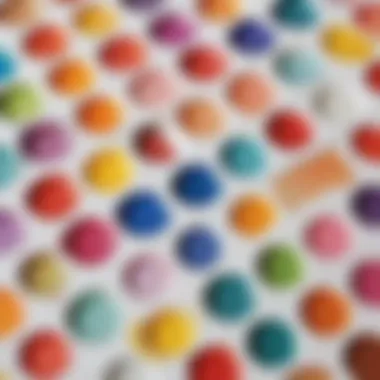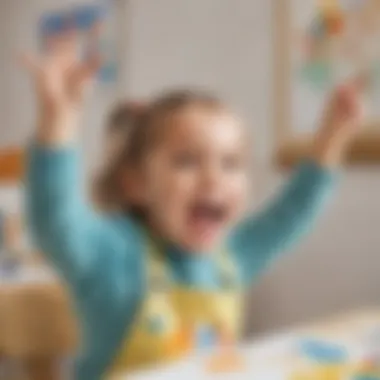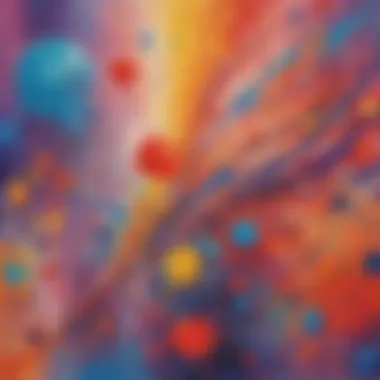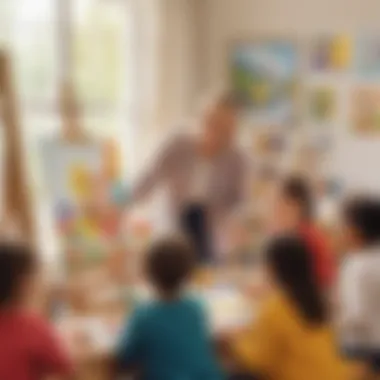Inspiring Painting Activities for Kindergarten: A Creative Guide


Fun Activities Ideas
Painting is a captivating activity for kindergarten children, sparking their creativity and nurturing their artistic expression. Engaging in painting activities provides a medium for young learners to explore their imagination and develop fine motor skills through the use of brushes, colors, and various painting techniques. For indoor activities, setting up a designated art corner with washable paints, brushes, and different types of paper can offer a safe and creative space for children to experiment with colors and shapes. Outdoor adventures can enhance the painting experience by allowing children to paint in nature, using leaves, twigs, and flowers as unconventional painting tools to create unique artwork.
Educational Games
Integrating painting with educational games can offer a holistic learning experience for kindergarten children. Math and logic games can be combined with painting activities by counting paintbrush strokes or creating geometric patterns with different colors. Language and vocabulary games can involve naming colors in multiple languages or describing emotions through abstract paintings. STEM activities can intertwine with painting through exploring color mixing and chemical reactions in paints. History and geography puzzles can inspire children to paint artifacts from different cultures or landmarks from around the world. Interactive learning apps can be incorporated to provide virtual painting simulations and art history lessons.
Seasonal and Holiday Activities
Celebrate special occasions and holidays with themed painting activities that engage kindergarten children in festive creativity. From Valentine's Day crafts involving heart-shaped paintings and handmade cards, to Halloween costume ideas where children can paint their own masks and decorations, painting becomes a central element in holiday celebrations. Thanksgiving cooking projects can include painting festive table settings or creating edible artworks using food coloring. During Christmas, painting decorations like ornaments and stockings can bring a personalized touch to home decor. New Year's resolutions for kids can involve setting painting goals, such as mastering a new technique or completing a series of themed artworks.
Parenting Tips and Resources
Parents and educators play a crucial role in fostering children's love for painting and art. Encouraging creativity involves providing ample opportunities for children to paint freely, without judgment, and praising their efforts to build confidence in their artistic abilities. Setting up a playful learning environment that includes colorful art supplies, inspiring art books, and displayed artwork can stimulate children's interest in painting. Balancing screen time and playtime is essential to allotting dedicated moments for creative activities like painting, which promote hands-on learning and sensory experiences. Building strong family bonds through collaborative painting sessions or visiting art museums encourages children to appreciate art as a shared experience. Motivating kids to stay active in painting requires setting achievable goals, offering constructive feedback, and participating in art-related activities together.
Fun Facts and Trivia
Explore intriguing facts and trivia related to painting and art that can captivate the curiosity of kindergarten children. Discover fascinating animal kingdom stories that inspire unique painting themes, such as animal habitats or features. Delve into the narratives behind famous inventions to spark children's imagination and creativity in their own artistic endeavors. Dive into historical events tailored for kids, connecting painting activities to significant moments in history to cultivate a sense of appreciation for the past. Venture into the realm of mythical creatures through painting projects that explore folklore and legends from around the world. Embark on space adventures with painting activities that depict planets, galaxies, and cosmic phenomena, igniting a passion for science and art in young learners.
Introduction
In the realm of early childhood education, painting stands out as a powerful medium for fostering creativity, expression, and cognitive development among kindergarten children. The act of painting goes beyond simple artistic exploration; it nurtures essential skills and abilities crucial for holistic growth. This article serves as a definitive guide to exploring various painting activities specifically curated for kindergarteners, outlining the significance of integrating art into their educational journey.
Importance of Painting in Early Childhood
Development of Fine Motor Skills
Painting plays a pivotal role in enhancing fine motor skills, which encompass the coordination of small muscle movements. Through the manipulation of paintbrushes and other art tools, children refine their dexterity and hand-eye coordination. This precise control not only aids in their artistic endeavors but also lays a solid foundation for future academic tasks that necessitate refined motor skills.
Enhancement of Creative Thinking
The process of painting encourages children to think imaginatively, fostering creativity from a young age. By visualizing concepts and bringing them to life on canvas, young artists stimulate their brains to explore innovative ideas and solutions. This creative liberty fosters a sense of autonomy and self-expression crucial for cognitive and emotional development.
Emotional Expression
Art, including painting, serves as a powerful outlet for emotional expression in young children. Through colors, strokes, and shapes, kindergarteners can communicate their feelings and experiences in a non-verbal manner. This form of expression not only aids in emotional development but also promotes introspection and self-awareness.
Benefits of Introducing Painting Activities at Kindergarten Level


Cognitive Development
Engaging in painting activities at the kindergarten level significantly enhances cognitive development. By experimenting with colors, textures, and spatial arrangements, children stimulate their brains and develop critical thinking skills. This cognitive engagement strengthens memory retention, decision-making abilities, and problem-solving skills essential for academic success.
Sensory Stimulation
The tactile nature of painting provides kindergarteners with rich sensory experiences. From the feel of paint on their fingertips to the smell of art supplies, children engage multiple senses simultaneously. These sensory stimulations not only enhance their artistic endeavors but also contribute to overall sensory integration and perception development.
Enhanced Communication Skills
Participating in painting activities promotes enhanced communication skills among kindergarten children. As they create and discuss their artworks with peers and educators, children learn to articulate their thoughts, listen actively, and express ideas coherently. These communication skills are foundational for building relationships, fostering teamwork, and developing social competence.
Types of Painting Mediums Suitable for Kindergarten
Exploring different types of painting mediums suitable for kindergarten is a crucial element in providing a well-rounded artistic experience for young learners. By introducing a variety of mediums, children can develop their creativity, motor skills, and sensory exploration. Choosing the right painting materials for kindergarten activities involves considering safety, ease of use, and the ability to create vibrant artworks that stimulate the imagination of children.
Watercolors
Introduction to Watercolor Techniques
Introducing children to watercolor techniques opens up a world of possibilities for artistic expression. Watercolors, with their transparent nature and blending capabilities, offer young artists the chance to experiment with color and texture fluidly. Understanding watercolor techniques not only enhances fine motor skills but also encourages children to explore light, shadow, and contrast in their artwork. While watercolors may pose challenges such as controlling water-to-pigment ratios, the unpredictable nature of watercolors adds an element of surprise and discovery to the painting process.
Exploring Color Mixing
Exploring color mixing with watercolors introduces children to the exciting world of color theory and experimentation. By blending primary colors to create secondary and tertiary hues, students not only learn about color harmonies but also develop critical thinking skills. Understanding color mixing allows kindergarten children to express their artistic ideas with confidence while honing their decision-making abilities. Although color mixing requires patience and precision, the joy of discovering new colors through mixing adds an element of excitement and discovery to painting activities.
Finger Painting
Benefits of Finger Painting
The tactile experience of finger painting offers young children a unique way to engage with art that goes beyond using traditional brushes. Finger painting allows kids to experience a sensory-rich artistic process, promoting tactile exploration and fine motor skill development. The freedom to use their hands as tools for painting encourages creativity and self-expression. While finger painting can get messy, the benefits of sensory engagement and non-verbal expression outweigh any cleanup concerns.
Engaging Texture and Sensory Experience
The hands-on approach of finger painting provides children with a textured sensory experience unlike any other painting method. Feeling the paint squish between their fingers and observing the tactile qualities of the artwork enhances children's sensory awareness. Engaging with different textures through finger painting stimulates creativity and imagination, fostering a deeper connection between the artist and their artwork. While the sensory experience of finger painting may require additional cleanup efforts, the tactile benefits far outweigh the temporary mess.
Tempera Paint
Versatility of Tempera Paint
Tempera paint, known for its versatility and quick-drying properties, offers kindergarten children a versatile medium for exploring a wide range of artistic techniques. From layering colors to creating bold strokes, tempera paint allows young artists to experiment with various painting styles. The opaque nature of tempera paint offers excellent coverage, making it ideal for creating vivid and expressive artworks. While tempera paint dries quickly, requiring prompt blending and application, its versatility in creating different effects makes it a popular choice for kindergarten painting activities.


Creating Bold and Vibrant Artworks
The bold and vibrant colors achievable with tempera paint inspire young artists to unleash their creativity and produce visually striking masterpieces. Creating artwork with tempera paint encourages children to work boldly and confidently, as the brilliant colors stand out on paper or canvas. The ability to mix and layer tempera paints empowers kids to experiment with color combinations and create dynamic compositions. Although handling tempera paint may necessitate organization and quick clean-up, the stunning results of bold and vibrant artworks make the process rewarding for both children and educators.
Setting Up a Creative Painting Area for Kindergarteners
In the realm of grooming young artistic minds, the significance of creating an enriched environment for kindergarteners to explore their painting abilities cannot be overstated. Setting up a creative painting area holds a pivotal role in nurturing a child's creative expression and fostering a love for art from an early age. By structuring a dedicated space for painting activities, children are encouraged to unleash their imagination and delve into the realms of color, shape, and form. This section delves into the essential aspects and benefits of establishing a conducive painting area for kindergarteners.
Organizing Art Supplies
Choosing Safe and Non-Toxic Materials
Safe and non-toxic materials form the cornerstone of a well-equipped painting corner for kindergarteners. Emphasizing the selection of materials that are harmless and child-friendly is paramount in ensuring a secure artistic environment. Opting for non-toxic paints, crayons, and papers guarantees the well-being of children during their creative endeavors. The advantage of such materials lies in their ability to foster artistic exploration without compromising on safety. A unique feature of non-toxic supplies is their assurance of creating a risk-free space where children can freely express themselves without any health concerns.
Creating a Well-Defined Painting Station
A well-structured painting station adds to the efficiency and allure of the creative area for young learners. By organizing paints, brushes, and other supplies in an orderly manner, children are empowered to engage autonomously in art activities. The key characteristic of a well-defined painting station is its ability to instill a sense of ownership and responsibility in children towards their artistic space. This setup promotes independence and minimizes disruptions, allowing for focused and immersive painting experiences. The advantage of a well-defined station lies in its capacity to invoke a sense of discipline and artistic dedication among kindergarteners.
Encouraging Independence and Creativity
Promoting Clean-Up Habits
Instilling clean-up habits as part of the painting routine cultivates a sense of tidiness and responsibility among young artists. Encouraging children to tidy up after their painting sessions fosters a clean and organized painting environment. The key characteristic of promoting clean-up habits is the development of a structured routine that nurtures respect for shared spaces. This practice not only teaches children the importance of cleanliness but also enhances their organizational skills. The unique feature of this approach lies in its ability to instill good habits that transcend the artistic realm, benefiting children's overall development.
Fostering Decision-Making Skills
Encouraging children to make artistic choices during painting sessions plays a crucial role in enhancing their decision-making skills. By providing opportunities for children to select colors, tools, and techniques, educators empower young artists to express their individuality. The key characteristic of fostering decision-making skills is its contribution to developing children's confidence and autonomy in their creative pursuits. This approach not only nurtures a child's self-expression but also hones their critical thinking abilities. The unique feature of this practice lies in its promotion of artistic decision-making as a means to build self-assurance and cognitive skills.
Exploring Theme-Based Painting Activities
As we delve into the realm of kindergarten painting activities, exploring theme-based painting activities emerges as a pivotal aspect of this educational journey. By immersing young learners in thematic painting experiences, we not only facilitate artistic expression but also nurture critical thinking and creativity. Theme-based activities provide a structured approach to art exploration, instilling a sense of cohesion and purpose in each painting session. The significance of theme-based painting lies in its ability to foster imagination, cultivate storytelling skills, and deepen children's understanding of the world around them.
Seasonal Art Projects
Creating Winter Wonderland Scenes
Delving into the creation of winter wonderland scenes within the context of kindergarten painting activities unveils a captivating avenue for artistic expression. This specific aspect allows children to experiment with blue and white hues, capturing the essence of a magical winter landscape. The temporary nature of snow in these scenes encourages children to embrace impermanence in art, fostering adaptability and creative problem-solving. Creating winter wonderland scenes becomes a popular choice in this article due to its relevance in connecting art with natural elements, inviting children to explore textures, tones, and spatial arrangement.
Springtime Floral Masterpieces


Transitioning to the realm of springtime floral masterpieces within kindergarten painting activities brings forth a burst of color and vitality. This particular aspect celebrates the beauty of nature through vibrant palettes of pinks, yellows, and greens, reflecting the essence of new beginnings and growth. The key characteristic of springtime floral masterpieces lies in their capacity to evoke joy, evoking a sense of renewal and optimism in young artists. The unique feature of such creations lies in their ability to blend realism with imagination, encouraging children to observe detail while infusing their personal flair into their artwork.
Animal Kingdom Creations
Jungle Safari Adventures
Embarking on jungle safari adventures as part of kindergarten painting activities immerses children in a world of exotic fauna and lush landscapes. The key characteristic of these adventures is the exploration of diverse textures and patterns found in jungle settings, igniting children's curiosity and appreciation for wildlife. Jungle safari adventures stand out as a popular choice in this article for their potential to stimulate sensory experiences and encourage children to depict movement and energy in their artwork. The unique feature of such creations lies in their power to bridge imagination with reality, prompting children to envision themselves on exciting wildlife expeditions.
Underwater Ocean Exploration
Venturing into underwater ocean exploration invites young artists to dive deep into the mysteries of the sea within kindergarten painting activities. The key characteristic of this theme is its play with vibrant blues and shimmering shades, mimicking the ever-changing colors of the ocean depths. Underwater ocean exploration emerges as a beneficial choice in this article due to its capacity to spark interest in marine life, fostering an understanding of ecological systems and conservation. The unique feature of such creations lies in their potential to awaken a sense of wonder and environmental awareness in children, encouraging them to appreciate the beauty and fragility of underwater ecosystems.
Incorporating Art History into Kindergarten Painting Lessons:
Art history serves as a crucial component in enrichening early childhood education by exposing young minds to the vast world of artistic achievements. By integrating art history into kindergarten painting lessons, children can develop a deeper appreciation for various art forms, learn about renowned artists, and understand the context behind famous artworks. This section aims to shed light on the importance of incorporating art history into the curriculum, emphasizing how it can enhance children's creativity, critical thinking skills, and cultural awareness. Understanding the roots of artistic movements and the evolution of different styles can empower young learners to express themselves artistically with a broader perspective.
Introducing Famous Artists and Their Works:
Van Gogh's Starry Night Interpretation:
Vincent Van Gogh's iconic masterpiece, 'Starry Night,' captivates viewers with its swirling night sky and luminous stars. Introducing young children to this renowned artwork can spark their imagination and curiosity about the night sky. The distinctive use of color and brush strokes in Van Gogh's Starry Night offers a gateway for kindergarteners to delve into the realm of expressionism and individual interpretation. By exploring Van Gogh's Starry Night, children can grasp the emotional intensity conveyed through art and inspire them to create their interpretations of the night sky, fostering creativity and emotional expression.
Picasso-Inspired Abstract Art:
Pablo Picasso's innovative approach to art revolutionized the perception of form and representation. Introducing children to Picasso-inspired abstract art can encourage them to break free from traditional norms and explore unconventional shapes and perspectives. The abstract nature of Picasso's creations allows young learners to embrace spontaneity and experimentation in their artistic endeavors. Picasso's influence can inspire kindergarteners to view art as a medium for self-expression and creativity without boundaries, fostering a sense of freedom and individuality in their artwork.
Understanding Different Art Movements:
Impressionism and Color Exploration:
Impressionism, known for its emphasis on light and color, introduces children to a world of vibrant hues and atmospheric effects. Exploring impressionism in kindergarten painting lessons can teach young artists about the importance of capturing fleeting moments and the interplay of light and shadow. By experimenting with color palettes and brush techniques inspired by impressionist painters, children can develop their observational skills and imbue their artwork with a sense of movement and luminosity. Understanding impressionism nurtures a deeper appreciation for nature's beauty and the art of seeing beyond the obvious.
Surrealism and Imaginative Expression:
Surrealism, characterized by dreamlike imagery and subconscious exploration, invites children to tap into their imagination and inner creativity. Introducing surrealism to kindergarten students encourages them to think beyond the conventional and delve into the realm of the fantastical. By exploring surrealistic themes and motifs, young artists can express their emotions and thoughts in unique and unconventional ways, fostering imaginative thinking and originality. Surrealism sparks a sense of wonder and curiosity in children, allowing them to create art that transcends reality and reflects their inner world.
Promoting Artistic Expression and Individuality
Embracing Mistakes as Learning Opportunities
To delve into the theme of Embracing Mistakes as Learning Opportunities, it is essential to comprehend the value of allowing children to experiment and make errors during the artistic process. Encouraging Experimentation is a key element within this concept, emphasizing the importance of exploring new ideas and techniques without fear of failure. By embracing mistakes, children learn resilience and perseverance, essential qualities for artistic growth and problem-solving skills. This nurturing of creativity through trial and error fosters a growth mindset and enhances a child's adaptability.
Building Confidence through Art is another fundamental aspect explored in this section. It focuses on the role of art in boosting a child's self-esteem and belief in their abilities. Through art, children learn to trust their instincts, make independent decisions, and take pride in their creations. Building Confidence through Art empowers children to express themselves authentically and overcome challenges, instilling in them a sense of accomplishment and self-worth.
Celebrating Diversity in Artistic Styles
Celebrating Diversity in Artistic Styles is a compelling theme that acknowledges the uniqueness of each child's creative expression. By supporting Varied Artistic Interpretations, educators and parents encourage children to explore different styles, techniques, and perspectives in their artwork. This inclusive approach promotes open-mindedness and appreciation for diverse forms of art, nurturing tolerance and acceptance among young artists. Valuing Each Child's Unique Perspective further reinforces this idea by emphasizing the importance of recognizing and honoring the individuality of every young artist. By valuing each child's perspective, children feel validated and respected, fostering a positive and inclusive artistic environment that celebrates the richness of varied artistic voices.



